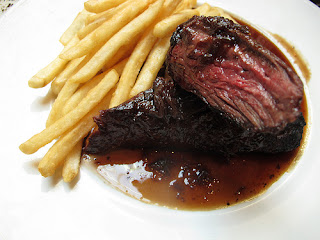from
Behind the French Menu
by
Bryan G. Newman
behindthefrenchmenu@gmail.com
Sweet potatoes.
Columbus brought the sweet potato back to Spain from South America. The sweet potato grew well in southern Europe, unfortunately, like the potato, it was considered poisonous. One group of sweet potatoes were appreciated; they were the group that had flowers called morning glories. Sweet potatoes were quickly accepted in France’s Caribbean territories but they would only make France's mainland restaurant menus in the 19th century; even then they were mostly pushed aside by the newly fashionable potato. The sweet potato finally became accepted as part of French cuisine in French restaurants some seventy or so years ago but was only accepted into French homes in the last forty or fifty years. Now sweet potatoes are popular everywhere and there are hundreds of recipes, with young sweet potato leaves and shoots sometimes eaten as greens. (The potato reached Spain 40 years after Colombus when the area now called Peru when in 1532 Francisco Pizarro conquered the Inca Empire and claimed the region and potatoes for Spain).
Purple sweet potatoes.
Photograph courtesy of Frieda's Produce
In much of North America, the sweet potato is often called a yam though the yam is very different and came from Africa to North America with the slave trade. The yam and the sweet potato are so often confused that I was told that 99% all vegetables labeled yams in the USA are in fact sweet potatoes.
More colors in sweet potatoes
Sweet potatoes on French Menus:
Dos De Cabillaud Rôti, Ecrasé De Patate Douce, Noisettes et Amandes Torréfiées – A thick cut from the back of fresh cod served with hand-mashed sweet potatoes and roasted hazelnuts and almonds. Dos is the back and for large fish and is considered the tastiest cut. Ecrasé translates into English as crushed but where potatoes and sweet potatoes are concerned it means hand-mashed.
Magret de Canard, Purée de Patate Douce, Jus de Cuisson – Duck breast and pureed sweet potatoes served with the duck’s natural cooking juices.
Pavé de Saumon Accompagné de Frites de Patate Douce – A large cut of Atlantic salmon accompanied by sweet potato fries, chips. The only salmon that may be found in the wild, off France’s coast, and is caught in her rivers is the Atlantic salmon. Ninety-eight percent of all imported, freshly chilled, salmon is farmed raised Atlantic salmon from Sweden.
Sweet potato fries(chips).
Pigeonneau du Haut-Anjou, Purée de Patates Douces et Épinards au Beurre – A young pigeon, a squab, farm raised in part of the historical French Duchy of Anjou that is now included in the department of Maine-et-Loire; it is served with a sweet potato puree along with spinach prepared with butter. Anjou, France, was the home of the English Plantagenet Kings.
Poêlée de Pétoncles sur Mousseline de Patate Douce – Lightly fried Icelandic scallops, the smallest member of the scallop family, served with a very fine puree of sweet potatoes. The word mousseline used here to describe the fine puree is taken from the fabric muslin. Muslin was used for creating very fine purees prior to the creation of fine steel strainers; hence mousseline.
More varieties of sweet potatoes.
Tartare de Boeuf et Huitres, Frites de Patate Douce a la Graisse d'Oie – A beef Tatar made together with oysters and served with sweet potato fries, chips, cooked in goose fat.
Sweet Potatoes are a tuber.
Sweet potatoes, like potatoes, are tubers that grow underground; but potatoes and sweet potatoes are not related. The distinctive shape of most of the sweet potato family usually includes a pointed end, and their outside skin comes in many colors; while inside the flesh may be white, ivory, pink, yellow, orange, mauve or purple. They are rich in fiber, vitamins A, C and B6, and an excellent source of carbohydrates.
Sweet potato soup made with a chili mango salsa.
www.flickr.com/photos/stuart_spivack/2118812679/
Most of the sweet potatoes that you see in French markets and on French menus will have been imported from France’s overseas departments. Sweet potatoes grow anywhere where the climate is warm, and that includes the south of France but they are even happier when the climate is tropical or sub-tropical. That means Guyane Française, just above Brazil, the Caribbean islands of Réunion and Guadeloupe, and the Indian Ocean Islands of Réunion and Mayotte. These overseas French departments are just as much a part of France as Corsica and so they are in the European Common Market. You may spend your Euros in the Caribean, South America or the Indian Ocean and have baguettes for breakfast and sweet potatoes for lunch and dinner.
Sweet potatoes ready for the market.
www.flickr.com/photos/usdagov/10581270186/
Sweet potatoes in the languages of France's neighbors:
(Catalan - moniato, boniato, batata or patata de Màlaga), (Dutch - zoete aardappel or bataat), (German - süsskartoffel, batate, or weisse kartoffel), (Italian - patata dolce, batat), (Spanish - moniato, papa dulce, patata dulce),
Connected Posts:
Behind the French Menu’s links include hundreds of words, names, and phrases that are seen on French menus. There are nearly 400 articles that include over 2,000 French dishes with English translations and explanations. Add the word, words or phrase that you are searching for to the words "Behind the French Menu" and search with Google or Bing.
Behind the French Menu
by
Bryan G. Newman
behindthefrenchmenu@gmail.com
Copyright 2010, 2017.





















